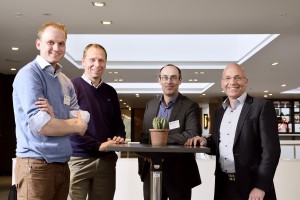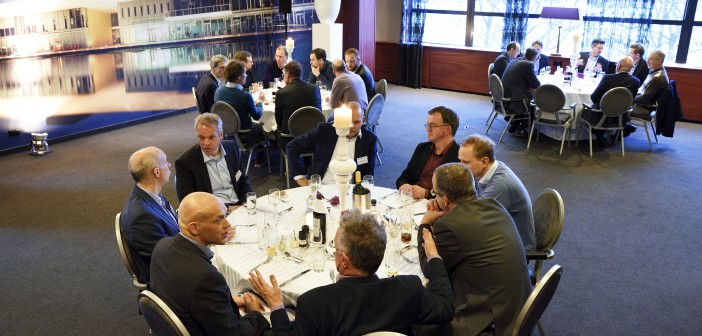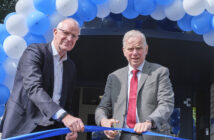
From left to right, Vincent Theunynck (Vintecc), Lucas Koorneef (MI-Partners), Tim Pattenden (Tessella) and Marcel Stakenborg (MathWorks Benelux).
MathWorks addresses engineers as well as executives
Under the impulse of trends like ‘big data’, MathWorks, a leading developer of mathematical computing software for engineers and scientists, is broadening its scope, from the technical disciplines to other – more business- and service-oriented – domains. To promote the broad spectrum of applications for its tools and their role in improving the effectiveness of R&D processes and hence the competitiveness of companies, MathWorks has started organising joint events for engineers and executives. Link Magazine reports on the March 2016 event in Eindhoven, the Netherlands.
MathWorks’ main products are MATLAB and Simulink. MATLAB is the language of technical computing that provides a programming environment for algorithm development, data analysis, visualisation, and numeric computation. Simulink is a graphical environment for simulation and Model-Based Design of multidomain dynamic and embedded systems. Traditionally these tools have been used for r&d and systems development in automotive, aerospace, communications, electronics, and industrial automation industries. However, more and more, these tools are also being utilised for modelling and simulation in other application fields, ranging from predictive maintenance to financial services to computational biology.
In parallel with this development, MathWorks is evolving from a software supplier to a strategic partner, Marcel Stakenborg, managing director of MathWorks Benelux, explains
during the one-day event in Eindhoven. ‘On days like this, we do not just want to show our products. We also present trends in industry and demonstrate the business aspects of  working with our products. I see developments going very fast, so we have to stay connected to the industry.’ Stakenborg refers among other things to Industrie 4.0, or Smart Industry as it is called in the Netherlands, the ongoing automation, robotisation and digitisation of industry. ‘It is gathering momentum, but the problem is that a lot of talk about these subjects is too abstract and academic, directed at the long term. People disconnect and management does not want to accept this kind of innovation even if significant savings lie ahead. A lot of companies are reluctant to embrace this new technology. Many industry executives have a mechanical engineering background, and software is new to them. We want to take away some of this fear by showing that it already works in practice. The gap between traditional engineering disciplines and new software-based approaches has to be bridged. Therefore, we want to demonstrate the business value of using tools like ours.’ In the theme for the event, it is articulated as follows: ‘To stay competitive, machine builders need to embrace simulation-based R&D, hardware-independent software development, and data analytics.’ In Eindhoven, representatives from MathWorks customers present their view on the matter and illustrate this with appealing cases.
working with our products. I see developments going very fast, so we have to stay connected to the industry.’ Stakenborg refers among other things to Industrie 4.0, or Smart Industry as it is called in the Netherlands, the ongoing automation, robotisation and digitisation of industry. ‘It is gathering momentum, but the problem is that a lot of talk about these subjects is too abstract and academic, directed at the long term. People disconnect and management does not want to accept this kind of innovation even if significant savings lie ahead. A lot of companies are reluctant to embrace this new technology. Many industry executives have a mechanical engineering background, and software is new to them. We want to take away some of this fear by showing that it already works in practice. The gap between traditional engineering disciplines and new software-based approaches has to be bridged. Therefore, we want to demonstrate the business value of using tools like ours.’ In the theme for the event, it is articulated as follows: ‘To stay competitive, machine builders need to embrace simulation-based R&D, hardware-independent software development, and data analytics.’ In Eindhoven, representatives from MathWorks customers present their view on the matter and illustrate this with appealing cases.
Simulation-based R&D
The first topic, simulation-based R&D, is covered by Lucas Koorneef, senior mechatronic systems designer at MI-Partners, the Eindhoven-based R&D company for high-end mechatronic products and systems. ‘We help customers in the early stages of product development to precisely define the specifications for their new machine. Sometimes the expectations of the customer are unrealistic. With modelling we can check whether specs are viable. If not, we can tell the customer not to try to design the impossible, and show him that when some parameters are changed a working machine can be designed. Based on our simulations we can come up with ideas that the customer never has thought of. Using models we evaluate these ideas and build up confidence in a design before we have actual hardware to test. Then we still build a prototype, to test the concept on actual hardware. As a mechatronic designer you have to get your hands dirty. Building and testing generates the gut feeling about things that work in reality or not. But we wouldn’t know how to do without modelling. It’s a basic tool in all our R&D and design processes.’ Machines are so complex nowadays, one has to take so many things into account, while there is no time for extensively building prototypes, testing them and modifying their design. ‘These steps can be done away with, now that we are virtually working first-time-to-right’, Lucas Koorneef says in conclusion, pointing at the savings earned with simulation-based R&D in the design phase, which in turn give rise to business gains due to the acceleration of market introduction.

Software development
Another benefit of Model-Based Design (MBD) is knowledge assurance, adds Vincent Theunynck, co-founder of Vintecc, a Belgium-based service provider that assists organisations in implementing MBD. ‘Traditionally, there may be some formal documents, but most of the innovation is in the heads of people. If you ‘externalise’ their knowledge through models, it is easier to share information and to set-up communication between all the disciplines involved.’ But perhaps the main advantege of MBD, according to Theunynck, is that software development has become hardware-independent. Next to simulation/modelling the second feature of MBD tools is automatic code generation. This code, for system control, can be tested using the models that were generated. It is independent of the final hardware implementation (mechanics as well as electronics), which can hence be determined in a late stage of the development process. This will speed up development and reduce (hardware) failure costs.
Theunynck presents the case of a multi-axle harvesting machine. Because of a short harvesting season, time for hardware testing was tight. MBD accounted for shortening of the development cycle by months, with 90% of the design being verified before hardware was available. This resulted in first field deployment without a single software error and, on top of that, the design delivered more features than the customer had initially requested for. ‘There is a great need in industry for these kinds of workflows, with automatic code generation, rapid prototyping and functional software-based testing. Yes, all this is possible with MBD.’
 Data analytics
Data analytics
And there’s a lot more possible using software and applied mathematics, as is demonstrated by Tim Pattenden, analytics consultant with Tessella, an international analytics and data science consulting services company. His company has for example developed complex control systems for aerospace applications, but Pattenden’s topic is more down to earth: the use of data analytics for predictive maintenance. The idea is that data can be gathered on the performance of a system or a process using all kinds of sensors. Subsequently, these data can be analysed using mathematical (including statistical) tools and software models to make predictions on future failure of system components for optimal planning of preventive maintenance. Pattenden discusses three cases, two successful ones (remote condition monitoring in a nuclear waste plant, and improvement of train fleet reliability) and an unsuccessful one (bioreactor contamination prevention), to reflect on the success criteria: which data analytics cases deliver business value and which ones don’t? It’s all about first deciding on the goals and the careful set-up of a data analytics business case, including the definition of feasible interventions, before just starting to gather data and analyse them, with the risk of finding ‘random’ correlations or ‘false-positive’ incidents.
The business value question is highly relevant, according to Pattenden. ‘For example, most of the blue-chip companies have bought big data analytics frameworks, but relatively few have used them to do anything successful. Companies like the Amazons, Facebooks and Googles of this world have large amounts of similar data which they have to process in real time. For them a big data platform may provide a lot of value. But, for instance, pharmaceutical or oil & gas companies have 100 different parts of business each with their own types of data and problems. In my experience, using one big data platform for the entire organisation is not helping their individual business units to get the data solutions they need. What they need is people who understand the analytics and the particular domain they are working in, rather than a 20 million euros big data platform.’ Software or hardware, it’s people that make a difference.






